2 Background
Study areas for 2022 field work included Brule Creek and Weigert Creek. Although portions of the Elk River watershed group flow into the Flathead River, streams included in 2022 fieldwork were within the portion of the Elk River watershed group that flows into the Elk River (Figure 2.1). The Elk River has a mean annual discharge of 26 m3/s at station 08NK016 near Sparwood and 47.3 m3/s at station 08NK016 near Fernie with flow patterns typical of high elevation watersheds on the west side of the Rocky Mountains which receive large amounts of precipitation as snow leading to peak levels of discharge during snowmelt, typically from May to July (Figures 2.2 - 2.4) (Environment and Canada 2020).
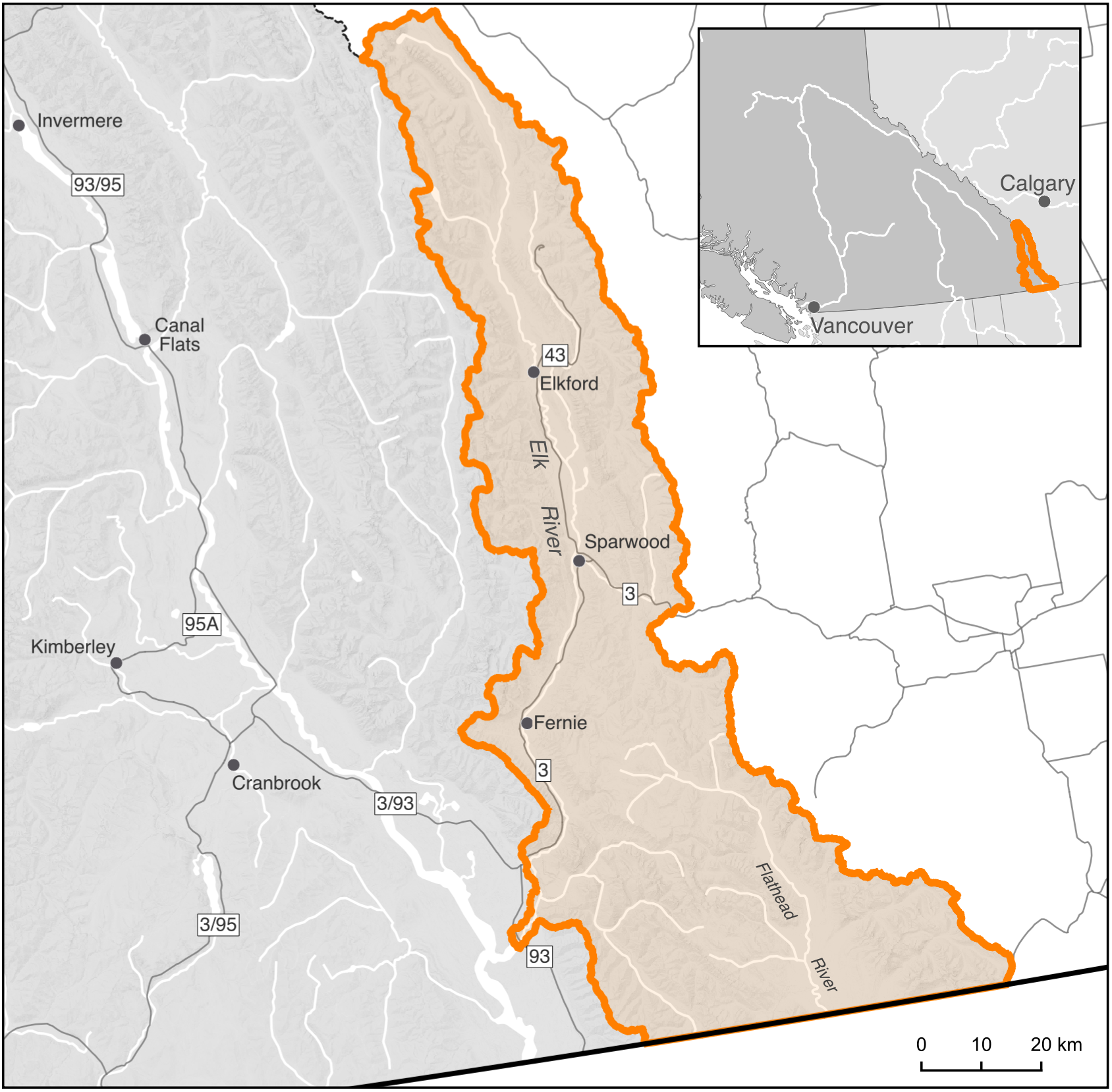
Figure 2.1: Overview map of Study Area
knitr::include_graphics("fig/hydrograph_08NK016.png")
knitr::include_graphics("fig/pixel.png")
knitr::include_graphics("fig/hydrograph_08NK002.png")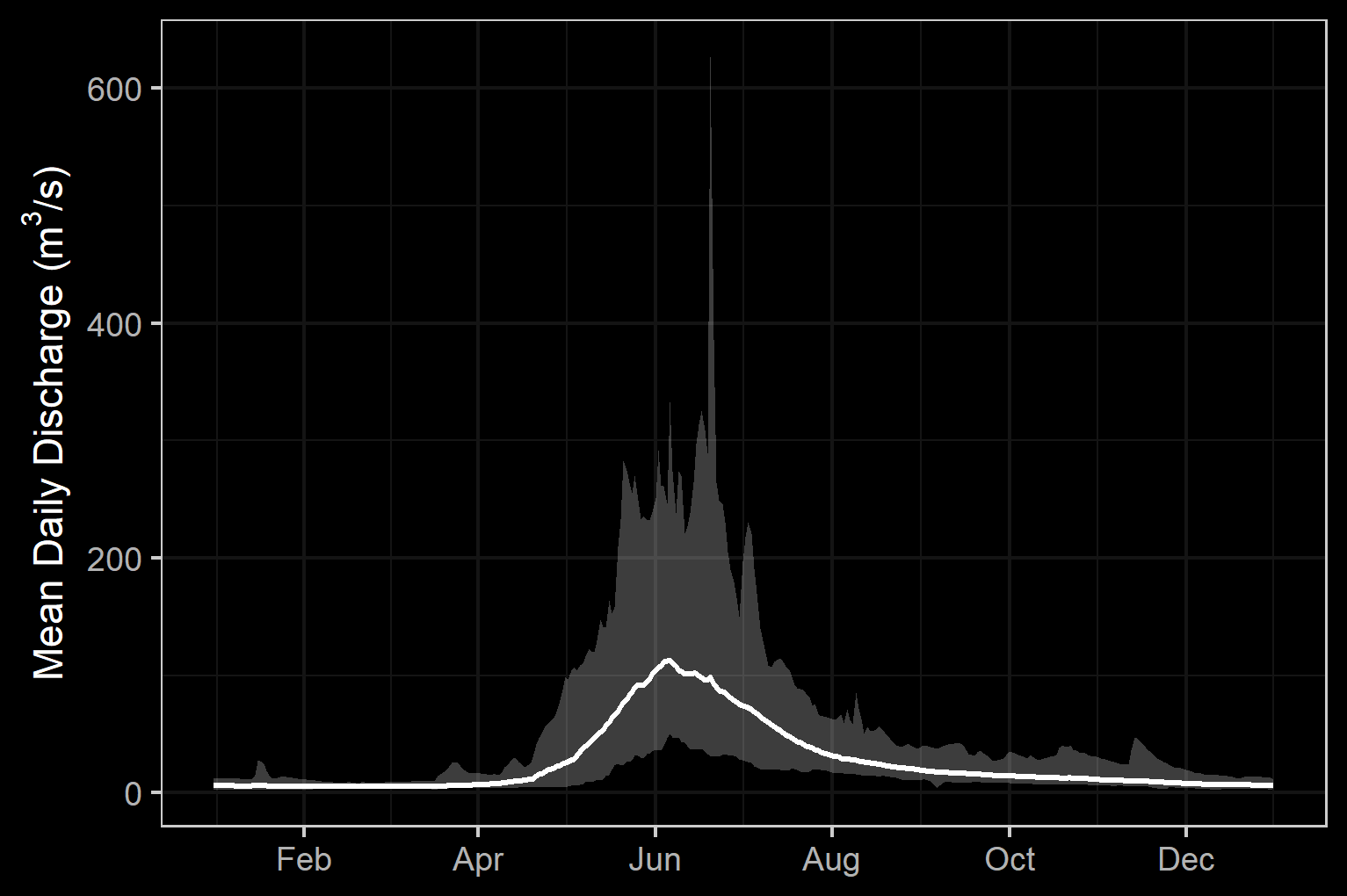
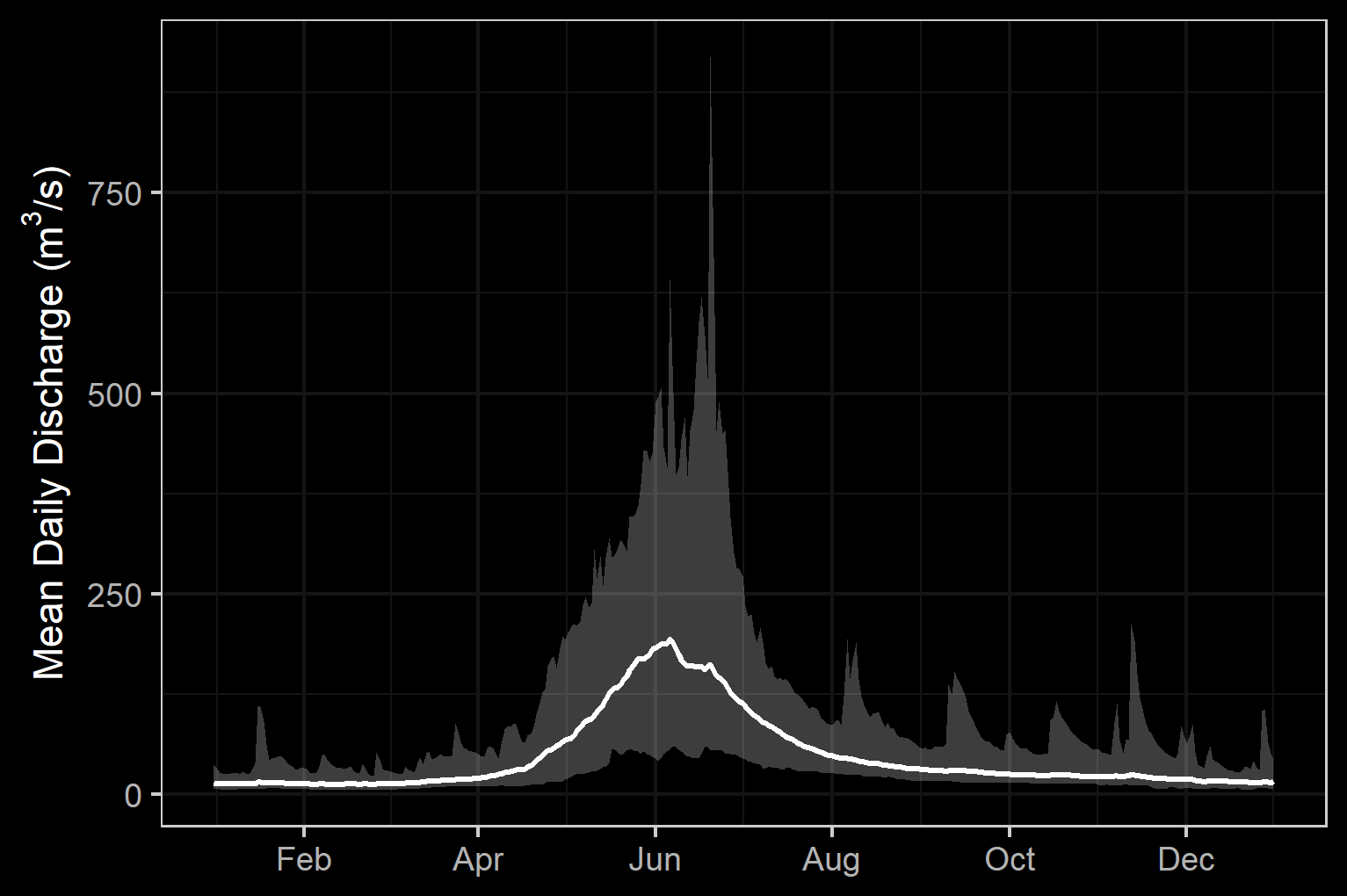
Figure 2.2: Hydrograph for Elk River near Sparwood (Station #08NK016) and near Fernie (Station #08NK002).
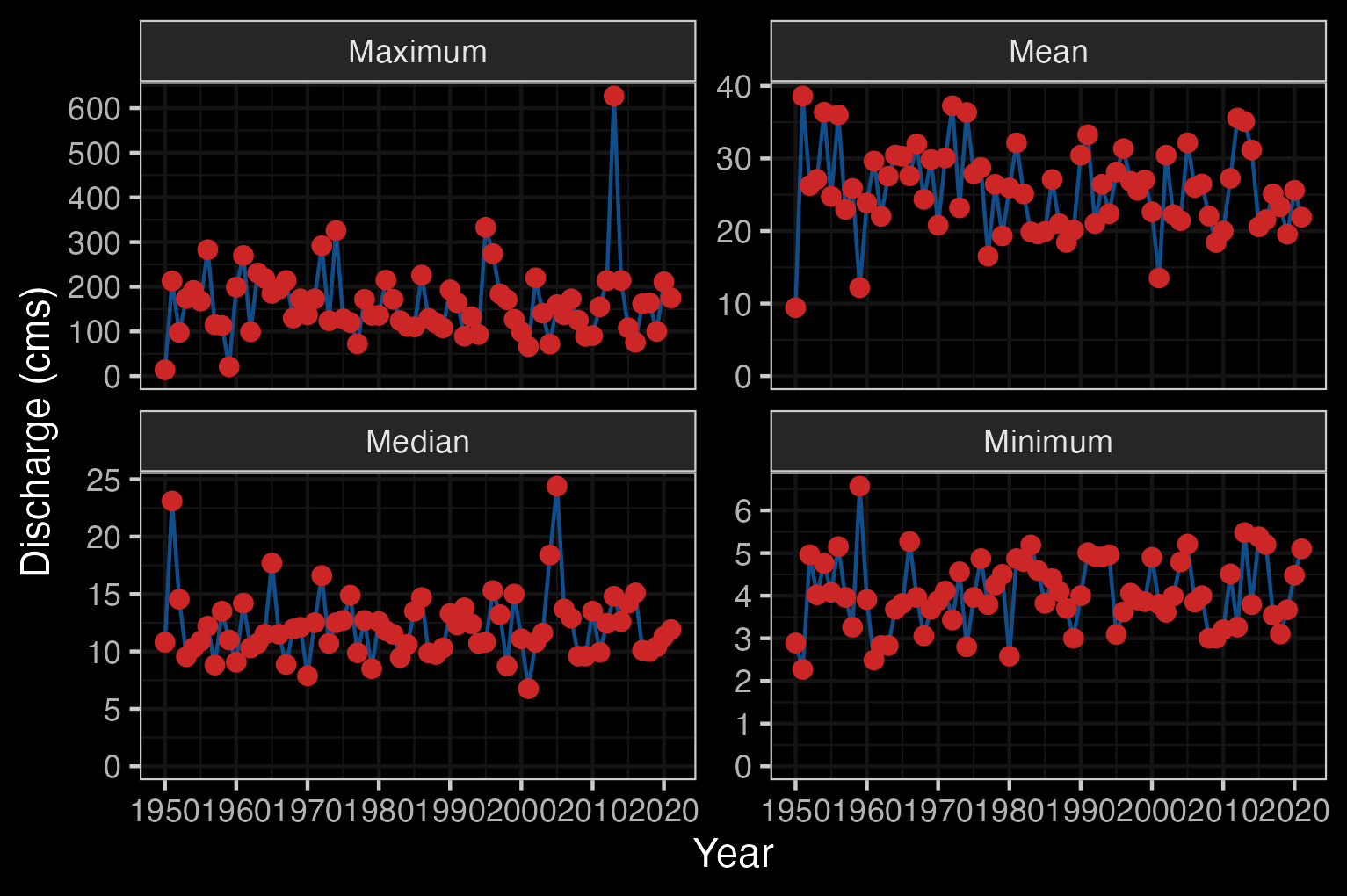
Figure 2.3: Elk River Near Sparwood (Station #08NK016 - Lat 49.86562 Lon -114.86868). Available daily discharge data from 1950 to 2020.
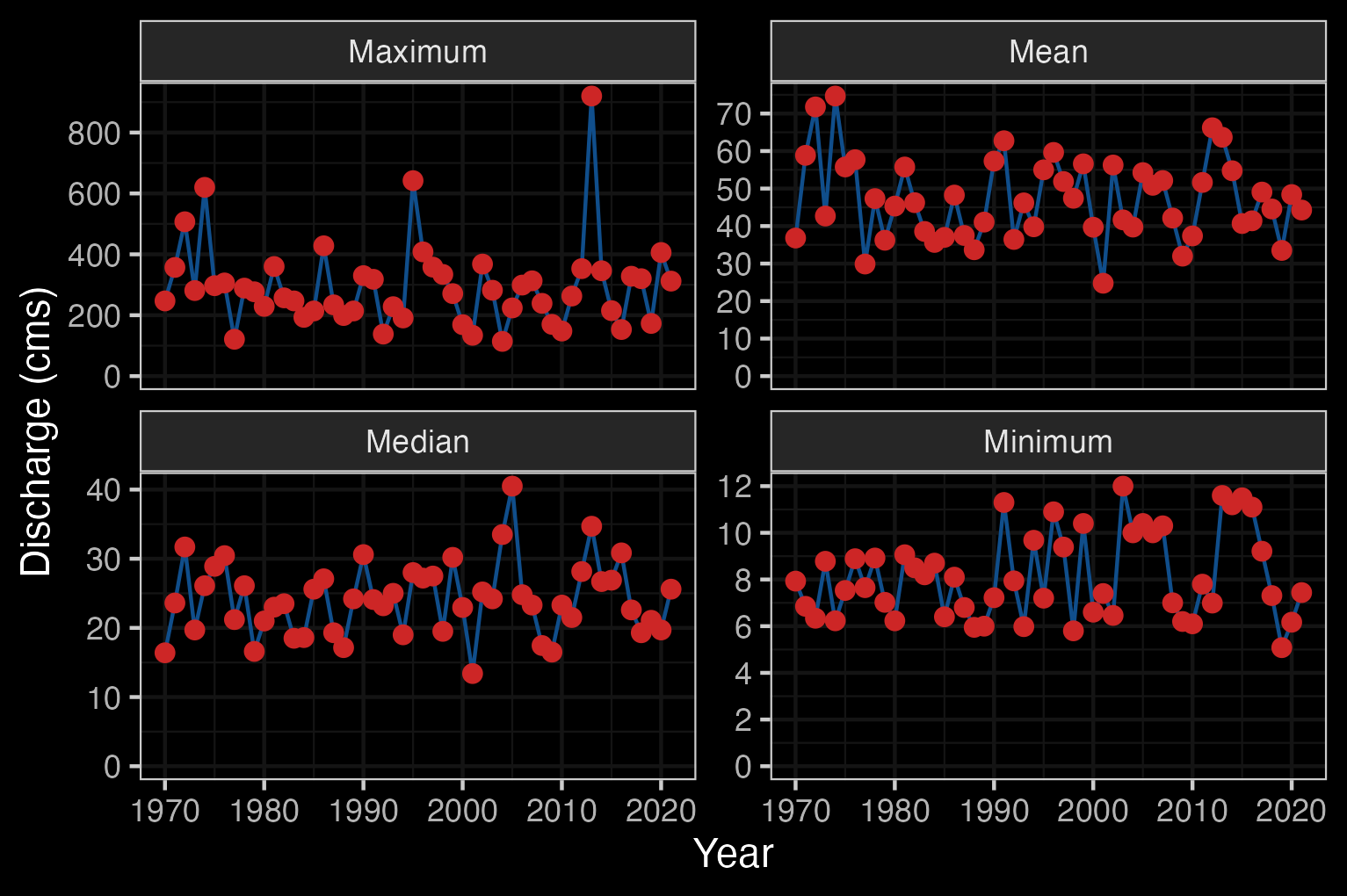
Figure 2.4: Elk River At Fernie (Station #08NK002 - Lat 49.50347 Lon -115.07013). Available daily discharge data from 1970 to 2020.
2.0.1 Ktunaxa Nation
The project location is within the traditional territory of the Ktunaxa Nation (“Ktunaxa Nation” 2020) with Elk River components within an area known as Qukin ʔamakʔis, or Raven’s Land (Ministry of Forests 2020). When Europeans settled in the Kootenay Region around 200 hundred years ago, the Indian Reserves were created which lead to the seven Indian Bands:
- ʔakisq̓nuk- Columbia Lake Band (Windermere, BC);
- ʔaq̓am- St. Mary’s Band (Cranbrook, BC);
- ʔakink̓umǂasnuqǂiʔit- Tobacco Plains Band (Grasmere, BC);
- yaqan nuʔkiy- Lower Kootenay Band (Creston, BC);
- kyaknuqǂiʔit- Shuswap Band (Invermere, BC);
- ʔaq̓anqmi- Kootenai Tribe of Idaho (Bonners Ferry, Idaho);
- k̓upawi¢q̓nuk- Ksanka Band (Elmo, Montana)
“Ktunaxa Nation” (2020) report the vision statement of the Ktunaxa as:
“Kȼmak̓qa ksukⱡuⱡa·k kuk̓qani ȼ k̓itqakiⱡ haqa ksiʔⱡ ȼxa ʔa·kⱡukqaʔis ksukiⱡq̓ukaʔmi·k kiʔin Ktunaxa naʔs ʔamak̓ʔis. Qus pik̓aksȼ naʔs ȼxaⱡ yaqanakiⱡ haqaʔki. K̓itqawiȼmu kakiⱡwiȼkiⱡ ʔamakʔis k̓isnikȼik kȼxaⱡ qa kiⱡkk̓axuxami·k k̓itqakiⱡ haqa ȼ k̓isʔin ʔaknumuȼtiⱡʔis.”
The vision statement has been translated to english as:
“Strong, healthy citizens and communities, speaking our languages and celebrating who we are and our history in our ancestral homelands, working together, managing our lands and resources, within a self-sufficient, self-governing Nation.”
2.0.2 Elk Valley Cumulative Effects Management Framework
# Coal deposits are located in the Elk River and Flathead coalfields which extend fromthe Canada-USA border to the northwest for 175km along the Rocky Mountains with cumulative coal thickness ranging up to 70m. Subsurface resource exploration and develpment is prohibited in the Flathead River watershed due to legislation enacted in 2011. At the time of reporting there were four active coal mines in the Elk River watershed (Fording River, Greenhills, Line Creek and Elkview), one closed mine (Coal Mountain) as well as multiple exploration projects and proposed new mines [@ministryofenergy2020EastKootenay].First Nations, stakeholders, proponents and provincial and municipal governments have recognized that the region has been impacted by historic and current coal operations as well as other stresses such as forestry operations, wildfire, residential development, recreational activities and transportation. To assess the historic, current and potential future conditions of valued ecosystem components and to support resource management decisions within the region, the Provincial Cumulative Effects Framework and the Elk Valley Cumulative Effects Management Framework (EV-CEMF) have been formed under joint management between the Ktunaxa Nation Council and the B.C. Ministry of Forests. A working group consisting of the Ktunaxa Nation Council, industry, community, organizations, and provincial government ministries has been formed to provide guidance and oversight for EV-CEMF activities. Valued component technical reports for Grizzly Bear, Riparian and westslope cutthroat trout (Davidson et al. 2018), bighorn sheep, and old and mature forest have been drafted, integrated into an overarching Cumulative Effects Assessment and Management Report (Elk Valley Cumulative Effects Management Framework Working Group 2018) and endorsed by the Working Group. These reports describe the historical, current, and future assessment of cumulative effects in the Elk Valley and provide management and mitigation recommendations. Next steps for the framework include the development of an Implementation Plan to identify priority actions and spatial locations to focus management and mitigation of cumulative effects in the valley which may include actions to address aquatic habitat connectivity issues (Ministry of Forests 2020).
2.1 Fisheries
Fish species recorded in the upper Elk River watershed group (streams that drain into the Elk River) are detailed in Table 2.1 (MoE 2020a). Bull trout and westslope cutthrout trout are considered of special concern (blue-listed) provincially and westslope cutthrout trout (Pacific populations) are are listed under the Species at Risk Act by the Committee on the Status of Endangered Wildlife in Canada as a species of special concern (BC Species & Ecosystem Explorer 2020b, 2020a; Schweigert et al. 2017).
fiss_species_table <- readr::read_csv(file = paste0(getwd(), '/data/inputs_extracted/02_prep_report/fiss_species_table.csv'))
# filter(`Species Code` != 'CT') %>%
fiss_species_table %>%
filter(`Upper Elk` != '--') %>%
select(-`Upper Elk`, -Flathead) %>%
# rename(Elk = `Upper Elk`) %>%
fpr::fpr_kable(caption_text = 'Fish species recorded in the study area (FISS 2020).')| Scientific Name | Species Name | Species Code | BC List | Provincial FRPA | COSEWIC | SARA |
|---|---|---|---|---|---|---|
| Catostomus catostomus | Longnose Sucker | LSU | Yellow | – | – | – |
| Catostomus columbianus | Bridgelip Sucker | BSU | Yellow | – | – | – |
| Catostomus commersonii | White Sucker | WSU | Yellow | – | – | – |
| Oncorhynchus clarkii | Cutthroat Trout | CT | No Status | – | – | – |
| Oncorhynchus clarkii lewisi | Westslope Cutthroat Trout | WCT | Blue | Y (Jun 2006) | SC (Nov 2016) | 1-SC (Feb 2010) |
| Oncorhynchus mykiss | Rainbow Trout | RB | Yellow | – | – | – |
| Oncorhynchus nerka | Kokanee | KO | Yellow | – | – | – |
| Prosopium williamsoni | Mountain Whitefish | MW | Yellow | – | – | – |
| Rhinichthys cataractae | Longnose Dace | LNC | Yellow | – | – | – |
| Richardsonius balteatus | Redside Shiner | RSC | Yellow | – | – | – |
| Salvelinus confluentus pop. 26 | Bull Trout | BT | Blue | – | – | – |
| Salvelinus fontinalis | Brook Trout | EB | Exotic | – | – | – |
| – | Cutthroat/Rainbow cross | CRS | – | – | – | – |
| – | Sucker (General) | SU | – | – | – | – |
2.1.1 Westslope Cutthrout Trout
There are multiple life history strategies for westslope cutthrout trout including stream-resident, fluvial and adfluvial. All have habitat requirements during life history stages that include cold clean water and varied forms of cover (undercut banks, pool-riffle habitat and riparian vegetation). Stream-resident fish inhabitat headwater streams above barriers, complete their life cycle within a relatively small range and typically remain relatively small (i.e. <200mm in length). Fluvial fish are migratory subpopulations that migrate between small spawning/rearing tributaries and larger adult rearing rivers. Lengths of fluvial fish generally reach more than 400mm. Finally, adfluvial subpopulations rear in lakes and migrate to spawning/rearing tributaries with lengths often exceeding 500mm (Schweigert et al. 2017).
Spawning habitat for resident and fluvial subpopulations are documented as within the tailouts of deep pools at moderate to high-flow events within small, low-gradient streams with cold well-oxygenated water and clean unsilted gravels (Schmetterling 2001). Proximity to large woody debris, boulder or bedrock cover is important for spawning fish while residing in spawning tributaries as high mortality may result when suitable cover is lacking. The dominant substrate used for spawning is gravel (1.8 - 3.3cm diameter) with spawning occurring in late May and June towards the end of the spring freshet with rising water temperatures between 7-11\(^\circ\)C.
References within Thorley et al. (2022) indicate that emergence of hatchery reared westslope cutthrout trout occurs after the eggs have accumulated 570 to 600 thermal units (Celsius degree days) which is consistent with estimates by Coleman and Fausch (2007b) of 570 to 600 Celsius degree days for Colorado Cutthroat Trout.
Nine of 11 westslope cutthrout trout radio-tagged in the Blackfoot River drainage, Montana by Schmetterling (2001) made movements to tributaries presumable for spawning. While in tributaries, fish movements to spawning sites averaged 12.5km where they stayed within an approximately 100m reach during the spawning period for between 15 and 63 days.
Small perennial streams with a diversity of cover are important for juvenile rearing with young-of-year fish inhabiting low energy lateral habitats (i.e. shallow riffle or backwatered areas) with cover available. Larger juveniles move into pools with social dominance behaviors prevalent and based on fish size. Availability of pool habitat is important and limiting for parr which have large territories (Schweigert et al. 2017; Schmetterling 2001). The suitability of overwintering habitat is determined by groundwater influx and the absence of anchor ice with fluvial adults congregating in slow deep pools in the winter. Boulders and other large in-stream structures or off-channel habitat (beaver bonds and sloughs) provide cover for juveniles with adfluvial fish overwintering in lakes (Schweigert et al. 2017; Brown and Mackay 1995; Cope, Schwarz, and Prince 2017).
Cold water temperatures have been demonstrated to provide recruitment bottlenecks in early life stages of westslope cutthrout trout with temperature days during the growing season above an average of 5\(^\circ\)C a key determinant in growth and subsequent fry survival during overwintering (Coleman and Fausch 2007a, 2007b). Ranges of Celsius degree-days during the growing season have been correlated to translocation success governed by recruitment and related to growth and subsequent overwintering survival for greenback cutthroat trout (_Oncorhynchus__clarkii__stomias) and Colorado River cutthroat trout (_O.__c._pleuriticus) in north-central Colorado headwater streams. Research detailed in Coleman and Fausch (2007b) indicates that for translocations of greenback cutthroat trout and Colorado River cutthroat trout in north-central Colorado headwater streams - streams that provide 800–900 degree-days probably sustain recruitment in some years, and report that streams with less than 800 degree-days are generally unsuitable for translocations because of the smaller sizes attained by fry before the onset of winter and the associated greater risk of recruitment failure.
In a swimming performance study conducted in an open-channel flume Blank et al. (2020) estimated the overall average swim speeds of westlope cutthrout trout (150mm - 290mm in length) at 0.84m/s with a maximum observed swim speed of 3.55m/s.
The greatest threats to westslope cutthrout trout have been identified as hybridization with non-native rainbow trout and degradation of the environment due to forestry, hydroelectric development, mining, urbanization and agriculture (Schweigert et al. 2017). Lamson (2020) sampled over 2000 trout in the Upper Kootenay watershed from 2014 to 2019 with results of genotyping indicating consistently high levels of westslope cutthrout trout allele purity (i.e. very low levels of rainbow trout, yellowstone cutthrout trout or coastal cutthrout trout genetic introgression) throughout the Elk River watershed areas upstream of the Elko Dam. Boyer, Muhlfeld, and Allendorf (2008) sampled 31 sites in the upper Flathead River system within the United States (27 sites) and Canada (4 sites). Genetic introgression declined with latitude with no evidence of rainbow trout allelles within any westslope cutthrout trout sampled within the Canadian portion of the upper Flathead River.
# load the csv built with R/02_prep_fig/analyze_fish_wct.R
wct_elkr_grad <- readr::read_csv(file = paste0(getwd(), '/data/inputs_extracted/02_prep_report/wct_elkr_grad.csv'))Gradient of streams is an important determinant of habitat suitability for salmonids with lower gradient habitats often providing the most productive environments for both rearing and spawning while high gradient sections typically present upstream migration barriers and less available habitat. A summary of historic westslope cutthrout trout observations in the Elk River watershed group delineated by average gradient category of associated stream segments where they were captured is provided in Figure 2.5. Of 4003 observations, 93% were within stream segments with average gradients ranging from 0 - 8%. A total of 73% of historic observations were within stream segments with gradients between 0 - 3%, 12% were within stream segments with gradients ranging from 3 - 5% and 8% were within stream segments with gradients between 5 - 8% (MoE 2020a; Norris 2020).
##bar graph
plot_wct_elkr_grad <- wct_elkr_grad %>%
ggplot(aes(x = Gradient, y = Percent)) +
geom_bar(stat = "identity")+
theme_bw(base_size = 12)+
labs(x = "Stream Gradient", y = "WCT Occurrences (%)") +
ggdark::dark_theme_bw()
plot_wct_elkr_grad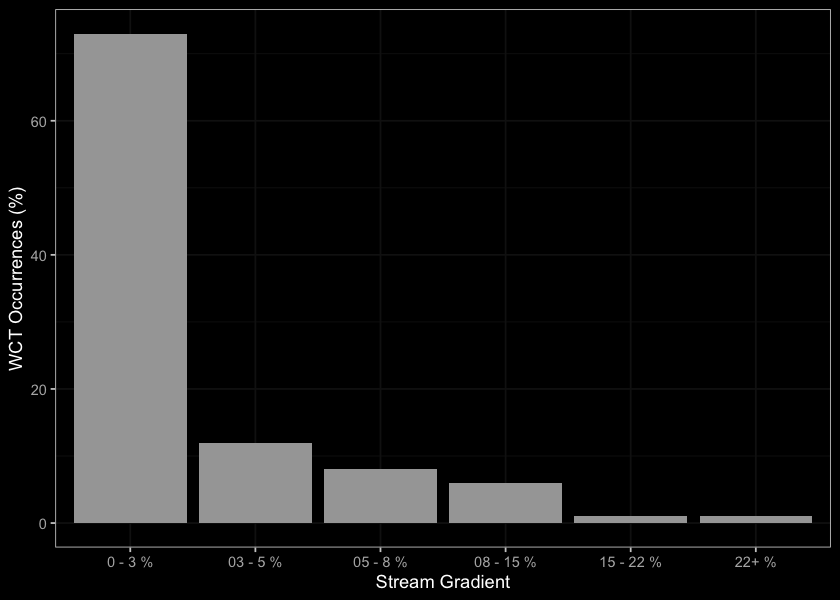
Figure 2.5: Summary of historic westslope cutthrout trout observations vs. stream gradient category.